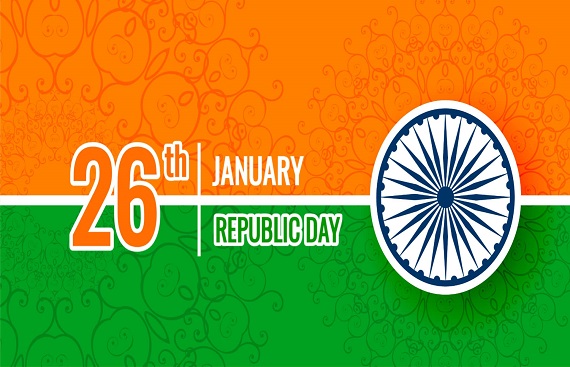Celebrating the Nation's 73rd Republic Day

History & Significance
Every year, Republic Day is commended in India on 26 January to celebrate the date on which the Constitution of India happened, and the nation turned into a republic.Consistently, 26 January is commended with merriments and devoted intensity all over the country. This year India will celebrate 73rd Republic Day to honor the Azadi ka Amrit Mahotsav, a few exercises were started in the approach Republic Day festivities 2022. The fundamental part of Azadi ka Amrit Mahotsav is to interface the adolescent to our rich social legacy. The exercise's reason is to discover the best ability the nation over. Likewise, to give a valuable chance to be a piece of Republic Day festivities 2022. But before that lets talk about why we celebrate Republic Day on January 26 every year.
Lets Begin with the Origin
![]()
At the point when India became Independent on fifteenth August 1947, our nation didn't have its Constitution and in complete it was subject to the frontier Government of India Act, 1935. Until the reception of the Constitution in 1950 India's head was King George VI. Yet, before this, a seed of the Indian conservative country was planted by Pt. Jawaharlal Nehru in the Lahore Session Indian National Congress. Presently, let us see the Lahore Session exhaustively.
While India's Independence Day commends its freedom from British rule, Republic Day praises the sanctioning of its constitution. No matter what the state or area of the country, Republic Day should be praised each year on January 26th. In spite of the fact that when India became autonomous on August 15, 1947, recalling the day on January 26, the Constitution of India was taken on around the same time. January 26th is important to the country's political history as it is the day the nation officially took on its constitution in 1950.This year likewise on the Republic Day march, India won't have a main visitor because of the worldwide circumstance emerging out of the COVID-19 pandemic. Every occasion held as a feature of the January 26 procession exhibition is set up beginning to end. The procession is expected to show the country's guard ability. The procession shows the protection capacity, social and social legacy of India. Twelve contingents of different Indian paramilitaries and police additionally participate in this procession.
The walk of the military, police and National Corps of Cadets additionally happens as the President of India gets the salute of a few regiments. The motorcade then, at that point, proceeds from Rashtrapati Bhawan to the Gateway of India where a few regiments of the Indian National Army walk with all their authority enhancements and designs and troops from different states perform social exhibitions portraying the nation's legacy. Heavenly processions in Janpat, New Delhi, in which the Indian National Army takes part, and the raising of the public banner in different pieces of the nation are a typical practice followed on this day. The Republic Day march in Delhi, facilitated by the Ministry of Defense, begins at the Rashtrapati Bhawan Gate and features India's protection ability, social and social legacy, and features the nation's variety.
The Constitution Of India
![]()
Since its first authority festivity in 1950, Republic Day has been praising the social solidarity of India with marches, energetic serenades, presentations and amusement. Republic Day is an authority occasion in India, praised each year on January 26 to honor the reception of the Indian Constitution. The Constitution of India was endorsed on January 26, 1950, and since that day, January 26 consistently has been assigned as Republic of India Day. India observes Republic Day to celebrate the day the Constitution of India came into power in 1950.
Republic Day is one of the three public occasions of India and remembers the reception of India's constitution, which occurred on January 26, 1950. Republic Day is praised on 26 January by each resident of India as on this day the "Constitution of India" came into power in 1950 supplanting the Government of India Act and India turned into a popularity based conservative country after acquiring autonomy from Britain in 1947 and turned into a republic. Republic Day is certainly not a customary occasion, it is the public occasion of India, it is significant for all Indians of all ranks and religions and is commended by all, albeit in the wake of acquiring freedom in 1947, India didn't turn out to be completely autonomous and followed it. The laws authorized by the British government keeping the recently declared "Constitution of India" led by Dr. Bheem Rao Ambedkar, India has turned into a perceived majority rules system on the world stage. This day is praised in India as a public occasion and denotes the start of another India, a really just and conservative country.
On an extraordinary day in 1950, India took on its Constitution and it happened, canceling the Government of India Act (1935) as the public authority report of India. India acquired freedom in 1947, however it was not until 1950, on January 26, that India accepted its constitution and government report. As per the 1950 constitution, the nation was formally known as the Republic of India, a "sovereign mainstream communist vote based republic" which, as indicated by its introduction, "guarantees to every one of its residents equity, freedom, fairness and fellowship." January 26 has been broadcasted Republic Day of India as it was on this day that the Indian National Congress (INC) announced the Declaration of Independence of India in 1930.
The date of January 26 was picked on the grounds that it was the day in 1930 that the Indian National Assembly announced Purna Swaraj, the affirmation of India's freedom from frontier rule. January 26 was picked as the date on which India's constitution came into power since it was the day in 1929 that the Indian National Assembly embraced the Indian Declaration of Independence (Purna Swaraj) contrary to British rule. On January 26, 1950, the Indian fundamental law came into power, setting up India's presence as an autonomous republic. On January 26, 1950, India's constitution was passed, shaking off its severe provincial pas
The archives building up the Charter were endorsed on January 24, 1950, and the Constitution formally came into power for the country on January 26, 1950. This was likewise the day that the main President of India, Dr. Rajendra Prasad, started his term. Today, the constitution of India has been taken on, and we have accomplished autonomy really. For our purposes, this is a pleased day that featured the delight of solidarity amidst variety.
Witness the Principle Fascination Of India’s Republic Day
![]()
On January 23, there will be a practice for the procession of the Republic Day march, which will begin at 9:50 am from Vijay Chowk and proceed at the National Stadium. Beginning at the Rashtrapati Bhawan (President's Residence), Raisina Hill on the Rajpath outside the India Gate, this occasion is the principle fascination of India's Republic Day festivities and goes on for three days. Although India became a free country on August 15, 1947, it did not achieve true independence until January 26, 1950, when the Indian Constitution entered into force.
The Constitution granted Indian citizens the authority to govern themselves by electing their own government.Dr. Rajendra Prasad took the oath of office as India's first President. Since that historic day, the 26th of January has been marked by celebrations and patriotic zeal throughout the country. The importance of the day can be traced back to the Indian constitution, which was promulgated on this day.
Read More News :
Amazon meets backlash for selling products with Tricolour imprint
84% of Indian Feel Like Service Is An Afterthought: Zendesk Study Consumers


.jpg)
